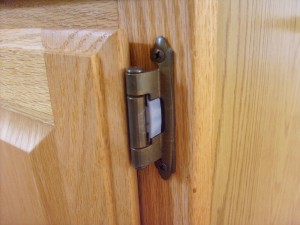 In this article (part one of a two part series) we will discuss the simplest way to repair the common household problem of loose hinges on doors and cabinetry.
In this article (part one of a two part series) we will discuss the simplest way to repair the common household problem of loose hinges on doors and cabinetry.
Kitchen and bathroom cabinetry are notorious for failing hinge attachment. After much repetitive use, often the cabinet hinge will wear loose causing the door to sag, and be unable to function properly.
Typically, standard cabinet hinges, including ‘self closing’ hinges may require a modest tightening of the screws, and the problem is solved. More often than not, the screws have become loose, wearing away the wood in which they are embedded, and no amount of tightening will hold the screw in place.
An easy fix for this problem is to inject some wood glue directly into the original screw pocket, then tamp in as many toothpicks, (wooden match sticks work well for this too) as can be forced into the pocket. Allow the glue to set up before trimming off the toothpick inserts flush with the face of the cabinet door, or trim. Don’t break off the extended portion of toothpick, rather cut it off using a serrated knife, or fine tooth saw. Once this is accomplished, you can re-screw the screw into the repaired pocket, and it will attach itself as tight and secure as it was when the cabinet was new. This repair technique is especially effective for repairs in particle board, laminates, and solid wood cabinet materials.
Loose hinges on passage or entry doors might be a bit more of a challenge to repair due to the weight of most doors.
Typically a problem occurs when the hinge screw wears away the wood from the door jamb where it is attached, and again, repairing the screw pocket is a good first option. Most door jambs are only ¾” thick, and although there will be a structural 2”x4” stud mounted directly behind the jamb, often this 2”x4” is not aligned with the hinge location. Door hinge screws are usually only 5/8” or ¾” long, and will only penetrate the jamb. This may not be enough attachment to hold a heavy door properly, and the weight of the door will eventually pull the hinge away from the jamb. Using the same technique to repair the hinge-screw pocket as we have previously discussed may work well. Another option would be to replace the center-most hinge screw with a screw long enough to penetrate both the jamb, and the 2”x4” stud behind it.
Using a hand or power drill, make a pilot hole (1/2 the diameter of the screw) in the screw pocket, penetrating the 2”x4”. Door hinge screws are often made from brass, and simply wont stand up treading into aged-hardened wood, so a pilot hole is recommended to prevent the screw from binding, or breaking as it is set. Apply a bit of bees wax (candle wax, or crayons work well too) along the screws threads before setting it to be additionally sure of an easy threading.
If you are looking for a professional contractor to help you with your project check out http://www.mylaborjob.com/find. It’s always free to use and you can find trusted local contractors for any kind of project.
Stay connected and informed. Like us on Facebook http://www.facebook.com/mylaborjob Special offers and insights posted regularly.



 Auto insurance quote
Auto insurance quote Get a Business Loan
Get a Business Loan